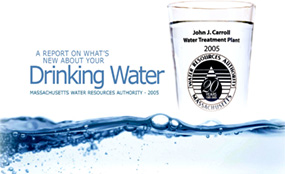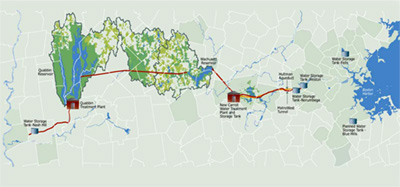| Home |
| Water System |
| Sewer System |
| Harbor and Bay |
| School Program |
| About MWRA |
| Doing Business with MWRA |
| Contact MWRA |
MWRA's Drinking Water Test Results for 2005
Massachusetts Water Resources Authority
Metropolitan Boston Version - html
Published June, 2006
|
This report is required under the federal Safe Drinking Water Act Public Law 104-12, Section 1414 (C), PWS ID #6000000
EXECUTIVE DIRECTOR'S LETTER
Dear Customer:
The Massachusetts Water Resources Authority is pleased to send you the annual report on your drinking water quality.
The report contains important information about the water we deliver to your home. Under strict federal and state guidelines, the MWRA and your local water department test thousands of water quality samples each week. The results for 2005 are excellent. MWRA again met every standard for the 120 contaminants we test for each year. With the start-up of the new, state-of-the-art John J. Carroll Water Treatment Plant in July 2005, your water is better than ever. MWRA now uses ozone gas - a powerful disinfectant - that provides better disinfection without the by-products of chlorine. The new treatment plant ensures strong protection against microbes and viruses, improved clarity, and taste and odor controls. We are pleased that people have noticed the improved taste since the plant came on-line.
I am also pleased to report that the lead test results for 2005 and the first half of 2006 show that system-wide, MWRA was below the federal Lead Action Level. However, some individual communities had more than one home above the Action Level. If you live in one of those communities, your town’s letter will provide you with additional information. It is important to remember that lead is not in the source water, but can enter the water through some household plumbing that contains lead. Please read our special section on lead to learn what MWRA is doing to help reduce lead at the tap and what you can do to reduce lead exposure in your home.
I hope you will take a few moments to read this report. The Board of Directors and the men and women of the MWRA take pride in being the stewards of one of the greatest water systems in the country. We want you to have confidence we have in the water we deliver to over 2 million customers. Please contact us if you have any questions or comments about your water quality, or any of MWRA's programs.
Sincerely,
Frederick A. Laskey
Executive Director
WHERE DOES YOUR WATER COME FROM?
The MWRA supplies wholesale water to local water departments in 50 communities, 44 in greater Boston and MetroWest, three in Western Massachusetts, and is a back-up supply for three others. This water comes from Quabbin Reservoir, about 65 miles west of Boston, and Wachusett Reservoir, about 35 miles west of Boston. MWRA supplied about 225 million gallons a day of high quality water to consumers in 2005, following a trend of decreasing demand.
|
Rain and snow falling on the watersheds - protected land around the reservoirs - turn into streams that flow to the reservoirs. This water comes in contact with soil, rock, plants, and other material as it follows its natural path to the reservoirs. While this process helps to clean the water, it can also dissolve and carry very small amounts of material into the reservoir. Minerals from soil and rock do not typically cause problems in the water. But, water can also transport contaminants from human and animal activity. These can include bacteria, viruses, pesticides, and fertilizers - some of which can cause illness. The test data in this report show that these contaminants are not a problem in your reservoirs’ watersheds.
The Quabbin and Wachusett watersheds are protected naturally with over 85% of the watersheds covered in forest and wetlands. About 75% of the total watershed land cannot be built on. The natural undeveloped watersheds help keep MWRA water clean and clear. Also, to ensure safety, the streams and the reservoirs are tested often and patrolled daily by the Department of Conservation and Recreation (DCR).
The Department of Environmental Protection (DEP) has prepared a Source Water Assessment Program Report for the Quabbin and Wachusett Reservoirs. The report notes that wildlife (birds and aquatic animals), agriculture, transportation corridors, transmission lines, and residential land use are the key issues in the watershed. The DEP report commends DCR and MWRA on the existing source protection plans, and states that our “watershed protection programs are very successful and greatly reduce the actual risk of contamination.” The report recommends that DCR and MWRA maintain present watershed plans and continue to work with the residents, farmers, and other interested parties to maintain the pristine watershed areas.
MAP OF THE MWRA WATER SYSTEM
FROM THE RESERVOIR TO YOUR HOME
MWRA’s New Water Treatment
As of July 2005, the water you drink is now treated at the new John J. Carroll Water Treatment Plant in Marlborough. The Carroll Plant uses ozone instead of chlorine to kill any pathogens (germs). This new treatment allows MWRA to meet current and tougher future state and federal water quality standards.
|
Water Treatment Steps - Carroll Water Treatment Plant
The first treatment step is primary disinfection of reservoir water. MWRA’s licensed treatment operators carefully add measured doses of ozone gas bubbles to the water to kill any germs that may be present in the water. Next, the water chemistry is adjusted to reduce corrosion of lead and copper from home plumbing (see page 5). Fluoride is then added to reduce cavities. Last, we add chloramine, a mild and long lasting disinfectant combining chlorine and ammonia, which protects the water while it is in the local pipelines.
MWRA'S IMPROVEMENTS TO THE WATER SUPPLY
MWRA has nearly completed its $1.7 billion Integrated Water Supply Improvement Program. The projects are the largest investments made in the water system since the Quabbin Reservoir was constructed in the 1930s. These improvements ensure that MWRA has made the necessary investments to maintain and upgrade its facilities, so that it can deliver quality water directly to customers’ taps 24 hours a day, seven days a week at less than a penny per gallon.
- MetroWest Water Supply Tunnel (2003) The tunnel is the backbone of the MWRA water system connecting the Carroll Water Treatment Plant to the greater Boston area.
- Water Storage Tanks (2004) Five new tanks have replaced MWRA’s older open distribution reservoirs protecting water safety. The cornerstone is the Norumbega Storage Tank in Weston – one of the largest covered storage tanks in the world.
- John J. Carroll Water Treatment Plant (2005) Modern water treatment using ozone.
MWRA is still working to improve the system. A covered storage tank in the Blue Hills area should begin construction this year. MWRA and local water departments continue to work to replace, clean, and reline both MWRA and locally owned older pipes to maintain the water’s high quality all the way to the tap.
RESULTS FROM TREATMENT INVESTMENT
The two charts below show how the new ozone treatment provides better disinfection while reducing the byproducts of chlorination.
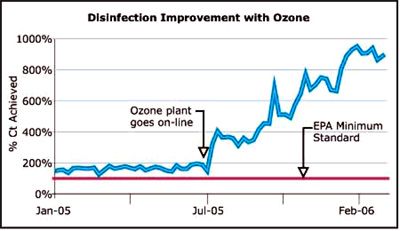
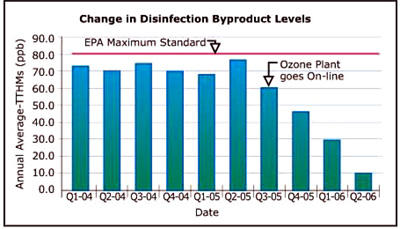
TESTING EVERY STEP OF THE WAY
Tests before treatment
We test the water as it leaves the reservoir to see how well protected our watershed is. Test results show that few contaminants are found in the reservoir water. The few that are found are in very small amounts, well below EPA’s standards.
Turbidity (or cloudiness of water) is one measure of overall water quality. Typical levels at Wachusett Reservoir are 0.4 NTU (Nephelometric Turbidity Units). In 2005, turbidity was always below both EPA’s standard of 5.0 NTU and the stricter Massachusetts standard of 1.0 NTU, with the highest level at 0.73 NTU.
MWRA also tests reservoir water for pathogens – such as fecal coliform, bacteria, viruses, and Cryptosporidium and Giardia. They can enter the water from animal or human waste. All test results were well within state and federal testing and treatment standards.
Tests after treatment
EPA and State regulations also require many water quality tests after treatment to check the water you are drinking. MWRA follows – and even goes beyond – these tests. We conduct tens of thousands of tests per year. This testing allows us to better monitor your water.
Tests in community pipes
MWRA and local water departments test 300 to 500 water samples each week for total coliform bacteria. Total coliform bacteria can come from the intestines of warm-blooded animals, or it can be found in soil, plants, or other places. Most of the time, these bacteria are not harmful. However, their presence could signal that harmful bacteria from fecal waste may be there as well. The EPA requires that no more than 5% of the samples in a given month may be positive for total coliform. If a water sample tests positive for total coliform, we run more specific tests for E.coli. E.coli is a pathogen found in human and animal fecal waste and may cause illness.
How did we do in 2005?
The table reports test results from 30 communities that receive all of their water from MWRA. Total coliform were found in 2 communities. No E.coli was found in any MWRA community in 2005. *One community exceeded the EPA standard. Residents of Southborough should read their community letter for more information.
TOTAL COLIFORM RESULTS |
||
| Community | Highest % of positive samples and month |
Violations of EPA's 5% Limit |
| Framingham | 1.3% (October) | No |
| Southborough* | 15% (July) | Yes |
| MWRA Transmission Line | 1.6% (August) | No |
| *Residents of Southborough should read their community letters for more information. | ||
RESERVOIR WATER TEST RESULTS - AFTER TREATMENT |
|||||||
Compound |
Units |
(MCLG) Ideal Goal |
(MCL) Highest Level Allowed |
(We found) Detected Level, Average |
Violation |
Range of Detections |
How it gets in the water |
| Barium | ppm | 2 | 2 | 0.1 | No |
0.006- 0.011 |
Common mineral in nature |
| Bromate | ppb | 0 | 10 | 1.82 | No |
nd-4.9 | Byproduct of water disinfection |
| Chloramine | ppm | 4-MRDLG | 4-MRDL | 1.27 | No |
nd-2.9 | Water disinfectant |
| Cyanide* | ppm | 0.2 | 0.2 | 0.03 | No |
nd-0.14 | Not Known - see below* |
| Fluoride | ppm | 4 | 4 | 1.04 | No |
0.04-1.23 | Additive for dental health |
| Nitrate ^ | ppm | 10 | 10 | 0.17 | No |
nd-0.17 | Breakdown of disinfectants, natural deposits |
| Nitrite ^ | ppm | 1 | 1 | 0.02 | No |
nd-0.02 | Breakdown of disinfectants |
Total |
ppb | ns | 80 | 76.7 | No |
3-136 | Byproducts of water disinfection |
| Haloactic Acids -5 |
ppb | ns | 60 | 40.5 | No |
0.6-116 | Byproducts of water disinfection |
KEY: MCL=Maximum Contaminant Level - The highest level of a contaminant allowed in water. MCLs are set as close to the MCLGs as feasible using the best available technology. MCLG= Maximum Contaminant Level Goal - The level of contaminant in drinking water below which there is no known or expected risk to health. MCLGs allow for a margin of safety. MRDL = Maximum Residual Disinfectant Level - The highest level of a disinfectant allowed in drinking water. There is convincing evidence that addition of a disinfectant is necessary for control of microbial contaminants. MRDLG=Maximum Residual Disinfectant Goal - The Level of a drinking water disinfectant below which there is no known or expected health risk. MRDLGs do not reflect the benefits of use of disinfectants to control microbial contamination. ppm = parts per million. ppb = parts per billion. nd = not detected. ns = no standard. ^Per DEP requirements, the maximum result is reported for nitrate and nitrite, not the average. *In over 10 years of testing, cyanide was never found anywhere in the water supply. It was detected in December 2005. MWRA is investigating lab method interference as the potential source. |
|||||||
WHAT DOES THIS TABLE TELL ME?
EPA requires that we test for over 120 contaminants.
A complete list is posted on mwra.com. MWRA found only those noted in this report.
WHAT IS THE BOTTOM LINE?
The water quality is
excellent. All of the levels are below EPA’s allowable limits.
LEAD IN YOUR TAP WATER: WHAT YOU SHOULD KNOW
MWRA water is lead-free when it leaves the reservoirs.
MWRA and local pipes that carry the water to your community are made mostly of iron and steel, and do not add lead to water. However, lead can get into tap water through pipes in your home, your lead service line, lead solder used in plumbing, and some brass fixtures. Corrosion or wearing away of lead-based materials can add lead to tap water, especially if water sits for a long time in the pipes before use.
What is MWRA doing to lower lead levels? What can I do?
In 1996, MWRA began adding sodium carbonate and carbon dioxide to adjust the water’s pH and buffering capacity. This change has made the water less corrosive, thereby reducing the leaching of lead into drinking water. Lead levels found in sample tests of tap water have dropped by over 80 percent since this treatment change. Also, local water departments are working to decrease lead corrosion by replacing existing lead service lines.
To further decrease your potential exposure, you should always use cold, fresh running water for drinking or cooking and buy plumbing fixtures that have no or low lead levels. Read the labels of any new plumbing fixture closely.
MWRA meets Lead Standard in 2005
Under EPA rules, each year MWRA and your local water department must test tap water in a sample of homes that are likely to have lead levels. These are usually homes with lead service lines or lead solder. The EPA rule requires that 9 out of 10, or 90%, of sampled homes must have lead levels below the Action Level of 15 parts per billion (ppb).
Lead levels in sampled worst case homes have dramatically dropped since 1992. Results for September 2005 are shown in the table, with an overall test score meeting the 90% standard. 9 out of 10 houses were below 13.8 ppb, which is below the Action Level of 15 ppb.
Some individual communities had more than one home test above the Action Level for lead. If you live on one of these communities, your town letter will provide you with more information.
SEPTEMBER 2005 LEAD AND COPPER RESULTS |
||||||
Units |
Range |
90% Value |
(Target) Action Level |
(Ideal Goal) MCLG |
# homes above AL / # homes tested |
|
| LEAD | ppb | 1.2-145 | 13.8 | 15 | 0 | 42/442 |
| COPPER | ppb | 0.01-0.93 | 0.15 | 1.3 | 1.3 | 0/442 |
| AL = Action Level: The concentration of a contaminant which, if exceeded, triggers treatment or other requirements which a water system must follow. MCLG = Maximum Contaminant Level Goal - The level of a contaminant in drinking water below which there is no known or expected risk to health. MCLGs allow for a margin of safety. | ||||||
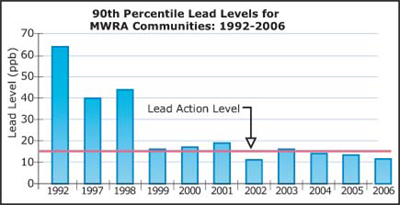
IMPORTANT LEAD INFORMATION FROM EPA
Infants and young children are typically more vulnerable to lead in drinking water than the general population. It is possible that lead levels in your home may be higher than in other homes in the community as a result of materials used in your home’s plumbing. Infants and children who drink water containing lead in excess of the Action Level could experience delays in their physical or
mental development. Children could show slight deficits in attention span and
learning abilities. Adults who drink this water over many years could develop
kidney problems or high blood pressure. If you are concerned about lead levels in your home’s water, you may wish to have your water tested and flush your tap until after the water is cold before using.
WHAT CAN I DO TO REDUCE EXPOSURE TO LEAD?
- Be careful of places you find lead in or near your home. Paint, soil, dust, and some pottery may contain lead.
- Run the tap until after the water feels cold. To save water, fill a pitcher and place in refrigerator for future use.
- Never use hot water from the faucet for drinking or cooking - especially when making baby formula or other food for infants.
- Ask your local water department if there are lead service pipes leading to your home.
- Test your tap water. Contact MWRA at 617-242-5323 or visit www.mwra.com/04water/html/testinglabs.html for more tips and a list of certified labs.
- Call the Department of Public Health at 1-800-532-9571 or EPA at 1-800-424-LEAD for health information.
IMPORTANT EPA AND DEP INFORMATION
|
Drinking Water and People with Weakened Immune Systems:
Some people may be more vulnerable to contaminants in drinking water than the general population. Immune-compromised persons such as persons with cancer undergoing chemotherapy, persons who have undergone organ transplants, people with HIV/AIDS or other immune system disorders, some elderly, and infants can be particularly at risk from infections. These people should seek advice about drinking water from their health care providers. EPA/CDC guidelines on appropriate means to lessen the risk of infection by Cryptosporidium and other microbial contaminants are available from EPA’s Safe Drinking Water Hotline (1-800-426-4791).
Contaminants in Bottled Water and Tap Water:
Drinking water, including bottled water, may reasonably be expected to contain at least small amounts of some contaminants. Their presence does not necessarily indicate that water poses a health risk. More information about contaminants and potential health effects can be obtained by calling the EPA’s Safe Drinking Water Hotline (1-800-426-4791) or MWRA (617-242-5323).
In order to ensure that tap water is safe to drink, EPA and the Massachusetts DEP prescribe regulations that limit the amount of certain contaminants in water provided by public water systems. Food and Drug Administration (FDA) and Massachusetts Department of Public Health regulations establish limits for contaminants in bottled water which must provide the same protection for public health.
Research for New Regulations
MWRA has been working with EPA and other researchers to define new national drinking water standards by testing contaminants which are not regulated. Our results will be used with those of other water suppliers to help EPA set regulations if they are necessary. MWRA is also participating with Tufts University on a nationally-funded study testing for Cryptosporidium and Giardia.
ONGOING RESEARCH FOR NEW REGULATIONS |
||
| Test | Measurement Units |
2005 Average |
| Aeromonas | cfu/100 ml | 0.04 |
| Cryptosporidium | oocysts per 100L | 0.04^ |
| Giardia | cysts per 100L | 0.06 |
| MTBE | ppb | 0.14 |
| Viruses | MPN/100L | 0.0002 |
ppb= parts per billion. |
||
WHERE TO GO FOR FURTHER INFORMATION
Health Issues
|
Massachusetts Department of Public Health (DPH) |
| US Centers for Disease Control & Prevention (CDC) http://www.cdc.gov (800) 311-3435 |
| List of State Certified Water Quality Testing Labs http:// www.mwra.com/water/html/qual6.htm (617) 242-5323 |
| Water Systems and Regulations |
| Massachusetts Water Resources Authority (MWRA) http://www.mwra.com (617) 242-5323 |
| Massachusetts Department of Environmental Protection (DEP) http://www.mass.gov/dep (617) 292-5500 |
| Department of Recreation and Conservation (DCR) http://www.mass.gov/dcr (617) 626-1250 |
| Source Water Assessment and Protection Report http://www.mwra.com/sourcewater.htm (617) 242-5323 |
| Public Meetings |
| MWRA Board of Directors http://www.mwra.com/02org/html/gov.htm (617) 788-1117 |
| MWRA Advisory Board http://www.mwraadvisoryboard.com (617) 742-7561 |
| Water Supply Citizens Advisory Committee http://www.mwra.com/02org/html/wscac.htm (413) 586-8861 |
If you would like more in-depth information on your water quality, a monthly report is available. Please visit our web site or call 617-242-5323. Thank you for reading this report.
WATER CONSERVATION
Wasting water can add up quickly. On average, a family of four uses 90,000 gallons of water each year; each person uses about 65 gallons of water each day. Consumers are discovering that more efficient water use can reduce the impact on the water supply and their wallets. Here are some ways to make your home and your habits more water efficient.
Fix Leaks
A leaky faucet is easy to see. But hidden leaks in the toilet, under the sink, or behind a washing machine can waste large amounts of water and can also damage floors and ceilings. Take a reading of your water meter. Check again in an hour. If the reading has changed, you’ve got at least one leak. Investigate!
Install a Low-Flush Toilet
Toilets account for over a third of the water used in most homes. Installing a new ultra low-flush toilet will save thousands of gallons each year and can reduce your bathroom water use by more than half.
Install a Low-Flow Showerhead and Faucet Aerator
Some showerheads may still use over 5 gallons per minute. A low-flow showerhead uses 2.5 gallons or less and can save you over 20 gallons per 10-minute shower. In one year, that’s over 7,000 gallons. Faucets can use 2 to 7 gallons of water per minute – a low flow-aerator can reduce the flow by about
25%.
Follow Outdoor Water Saving Ground Rules
Summer is an especially important time to save water. Water consumption can increase up to 50% in the summer months due to outdoor water use.
- Water your lawn (and other landscaping) in the early morning or evening to avoid evaporation.
- Be sure sprinklers water only your lawn, not the pavement.
- Never water on a windy, rainy, or hot day.
- Never use the hose to clean debris from your driveway or sidewalk. Use a broom.
- Apply mulch around flowers to reduce evaporation, promote plant growth, and control weeds.
The Inch Rule
Most lawns, shrubs, vegetables, and flowers need just one inch of water per
week. if there has been an inch of rainfall during the week, you don’t have to
water at all. Overwatering can actually weaken your lawn by encouraging shallow roots that are less tolerant of dry periods and more likely to be damaged by insects.
More Tips
For more water saving ideas, call 617-242-SAVE or go to www.mwra.com.
SHARE YOUR THOUGHTS.
If you have comments or questions about this report, please contact us. Email: joshua.das@mwra.state.ma.us, call (617) 242-5323, or send a letter to: MASSACHUSETTS WATER RESOURCES AUTHORITY, 100 FIRST AVENUE, BOSTON MA 02129.
Some files on this site require Adobe Acrobat Reader®. (Free download).
Updated August 9, 2006
